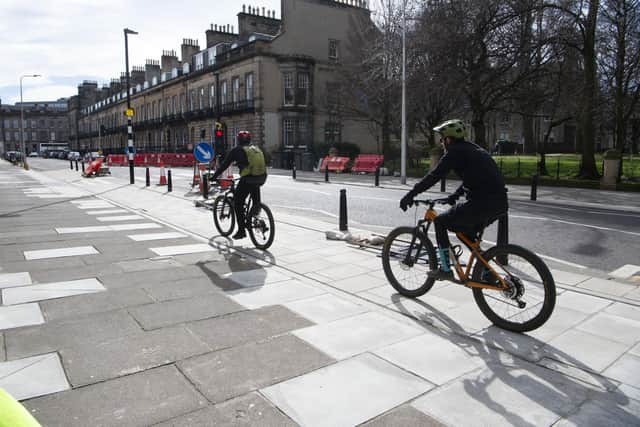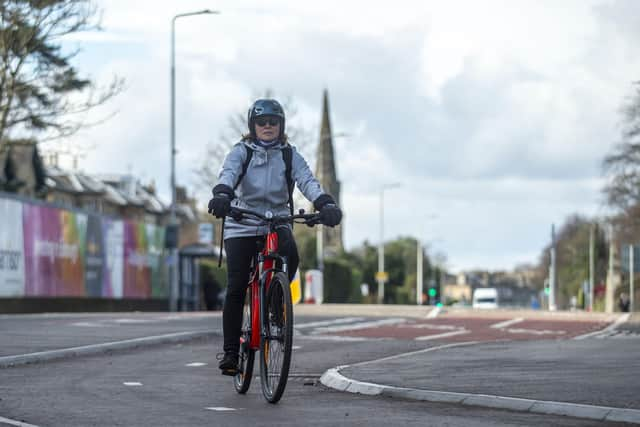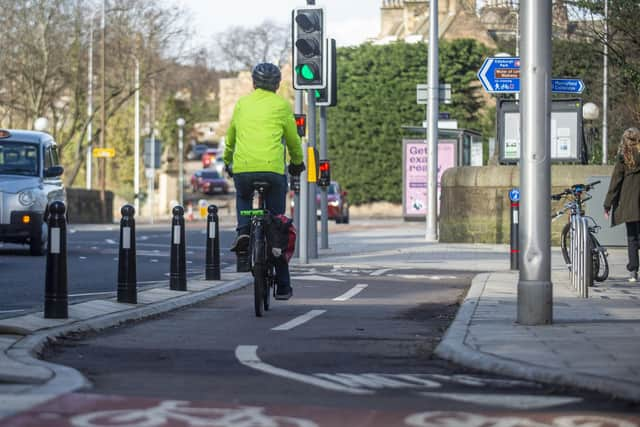Edinburgh’s City Centre West to East Link cycle route opens with key George Street section missing
It’s Edinburgh's longest segregated bike lane, providing a safe route for cyclists crossing the city centre – but it has taken a decade to materialise and will be officially opened on Wednesday with its central section still to be built.
The two-mile City Centre West to East Link (CCWEL) has had a “very tortuous history”, according to Lothian cycle campaigners Spokes, which it blamed on objections to the scheme, such as vehicle restrictions at junctions, “labyrinthine” Scottish Government traffic regulations and council staffing cuts.
Advertisement
Hide AdAdvertisement
Hide AdHowever, by creating dedicated lanes separated from other traffic with kerbs rather than just lines on a pavement, it could be a game changer in encouraging more people to cycle, and become a catalyst for the development of similar routes across the city.
The £19 million project links Roseburn in the west with York Place at the east end of the city centre, providing connections to cycle routes at either end – the Roseburn Path in the west and Leith Walk in the east. However, the stretch along George Street in the middle of the route is not expected to be built until next year because the Edinburgh City Council said it was part of a separate project.
Most of CCWEL, which is parallel to the traditional main route into the city centre from the west, is segregated, with some sections on quiet roads in the West End.
Starting from the Water of Leith bridge on Roseburn Terrace, it runs east along West Coates, past the former Donaldson’s School, and along Haymarket Terrace, then turns north onto Roseberry Crescent, and east onto Grosvenor Crescent.
CCWEL then skirts the south side of St Mary’s Cathedral, turns north into Manor Place and then east along Melville Street before crossing Queensferry Street onto Randolph Place and via a cut-through to Charlotte Square on the north side of West Register House.


Between there and St Andrew Square, the section along George Street has yet to be added. The completed part of CCWEL resumes on North St David Street, on the north-west corner of St Andrew Square, then heads along York Place to connect with another cycleway at its eastern end at Picardy Place.
The city council has described the "landmark” scheme as “the biggest piece of cycling and walking infrastructure the city has seen yet", that would provide a “high-quality, safe and dedicated walking, wheeling and cycling route”.
Underlining the significance of Wednesday’s “momentous occasion”, active travel minister Patrick Harvie will take part in its official opening at 1pm beside the Four Points by Sheraton Hotel on Haymarket Terrace.
Advertisement
Hide AdAdvertisement
Hide AdThe event comes six months after the Scottish Government’s outgoing active travel commissioner Lee Craigie wrote to Mr Harvie of her frustration at cycling projects being "drowned in procurement processes”.


Transport Scotland said at the time: “We will take on board her comments as we continue our review of our approach to active travel delivery for 2024/25.”
That could be key in streamlining future projects to encourage more cycling since ministers have set a target of reducing vehicle kilometres by 20 per cent by 2030, with the city council pursuing an even more ambitious 30 per cent cut.
Spokes has welcomed CCWEL as a “massive step forward” because it represented a “substantial main road reallocation of road space from car to bike”.


The campaigners also applauded the council for making the plans to extend the route west to Corstorphine and the Gogar roundabout a priority, and they called for improvements to Princes Street because it was the “route of choice” for many cycle trips.
However, Spokes is exasperated at how long it has taken CCWEL to be realised, referring to the “astonishing length and complexity” of the saga.
Dave du Feu, of the group, said: "Both the council and the Scottish Government (who set the rules for traffic orders) must do a lot more to end the project delays which have plagued this and many other schemes.”
A test ride by The Scotsman on Monday highlighted the different feel of the route to cycle on compared to other segregated routes in both Edinburgh and Glasgow, which seemed safer thanks to more substantial protection from other traffic, such as fencing on York Place.
Advertisement
Hide AdAdvertisement
Hide AdBollards on other sections also prevent the lanes being blocked by delivery vans and other vehicles. Such features provided an experience more akin to cycling in a European city than in Scotland.
Cyclists’ priority when passing side roads is emphasised with pavements being extended across the junctions, which motorists have to drive over to get on and off the main road. Dedicated traffic lights have also been provided for cyclists at many junctions, which provide further reassurance.


However, the route was confusing to follow in a few places, such as where it turns from Manor Place into Melville Street beside St Mary’s Cathedral, because the material used is the same type as the pavement.
The city council said it had used slabs for the cycleway on either side of the cathedral “in response to the special status of these areas as part of the setting of this Category A listed building and major local landmark”, but it would be monitoring “how well these sections work”.
But the biggest issue is the gap in the scheme in George Street. The council said it had not repainted the faded markings on the street’s cycle lanes because “George Street is a separate project, [so] changes like these aren’t within scope for this contract”.
A council spokesperson said the George Street section of CCWEL “will follow once designs and legal processes have been completed, adding: "The existing National Cycle Network route runs along George Street. CCWEL has always intended to connect to George Street, and still delivers an enormous improvements in provision of quality active travel infrastructure in the city centre with George Street in its current layout.”
Comments
Want to join the conversation? Please or to comment on this article.